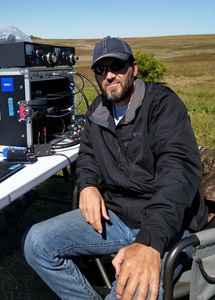Supporting DARPA and the Real-World Impact of Northrop Grumman’s Culture of Curiosity
Moving at the Speed of Laser
Enabling Tomorrow’s Space Missions with Laser Communications
By Caroline Mroz
In science fiction movies, we don’t give interplanetary communications a second thought — sending a message that crosses galaxies and lightyears is as easy as ordering a pizza. In reality, communicating with even our neighboring planets can be an arduous task. For example, if you were to be dropped on Mars right now, it could take weeks for your messages to reach Earth using current communications systems.
Fortunately, for over four decades, our team at Northrop Grumman has been developing a revolutionary technology with the power to underpin the next generation of space missions, including humankind’s journey to Mars and beyond: laser communications.
Currently, transmitting data from space to Earth is a process that often requires a heavy dose of patience. It can be a waiting game of days, weeks or even months thanks to several factors, explained Northrop Grumman Fellow Scott Nuccio. Not only is the radio frequency (RF) spectrum increasingly congested, the quantity and quality of data being collected is higher than ever before, resulting in slowdowns. Scientists, warfighters and policymakers — whose work often depends on information transmitted from a satellite or spacecraft — feel the impact of this delay.
“There’s this inverse relationship between the amount of data being collected and the ability to get that data home,” said Scott.
Breaking this communications bottleneck is no longer a long-term goal; it’s a necessity for tomorrow’s missions, which are being architected today. Addressing this gridlock is critical for enabling missions that aspire to go further and faster than ever before, including deep-space exploration and military satellite constellations. Scott — who is working with customers to plan missions that will be deployed and operational through 2040 or 2050 — said achieving the full potential of these ambitious plans will require next-level communications technology.
Breaking the Bottleneck
Like traditional RF communications, laser communications transmit data from space to a ground receiving station. However, instead of using radio waves, laser communications use very narrow laser beams which, due to their high frequency, can transmit significantly more data per second.
The difference in speed between RF and laser communications is comparable to going from dial-up to fiberoptic internet, and similarly transformative. For example, a complete map of Mars could be transmitted to Earth in nine days with laser communications as compared to nine weeks with RF communications, according to NASA.
“The instruments we build for space science do one job: look at the universe in some way, shape or form, turn that data into bits and get those bits to the ground, where they turn into science,” said Northrop Grumman Chief Mission Architect for Science and Robotic Exploration Jon Arenberg. “The faster and more efficiently we can get those bits to the ground without putting additional constraints on the product design, the better performing our products are.”
Laser communications systems’ low size, weight and power, known as SWaP, is another advantage. The relatively low SWaP of laser communications systems leaves more SWaP available for the primary mission of the satellite, making this technology appealing for missions with high data rate requirements — for example, the next generation space telescope or missions to Mars and beyond.
Optical Realities
Since laser communications brings a significant reduction in SWaP, many of the first applications are in space. In December 2021, NASA launched its Laser Communications Relay Demonstration (LCRD) aboard Northrop Grumman-built satellite STPSat-6. LCRD is NASA’s first two-way laser communications relay system which, according to NASA, transmits data at 1.2 gigabits-per-second between in-orbit satellites and two ground stations, demonstrating the powerful communications capabilities of this technology.
“It was a very exquisite payload that demonstrated the art of the possible, quite literally, for many future missions,” said STPSat 6 Program Director Ray Crough.
NASA reports that a laser communications terminal will also be installed on the Orion spacecraft as part of its upcoming Artemis II mission, allowing astronauts to send back high-definition video — a far cry from the grainy black-and-white video of Neil Armstrong’s Moon walk that Jon said he recalls watching as a child. One day, laser communications could even enable connectivity for hard-to-reach locations, from the battlefield to rural communities to inflight during air travel.
“This technology has the ability to change everyone’s experience,” said Jon. “It’s going to make the remote corners of our solar system come through in high definition, offering us a whole new toolkit.”
Read more about some of our groundbreaking work in laser communications, and discover what it’s like to work at Northrop Grumman.
Solving the Toughest Problems
Whether you want to design next-generation aircraft, harness digital technologies or build spacecraft that will return humanity to the moon, working at Northrop Grumman means you’ll contribute to technology that’s transforming the world. Check out our career opportunities to see how you can help define possible.


